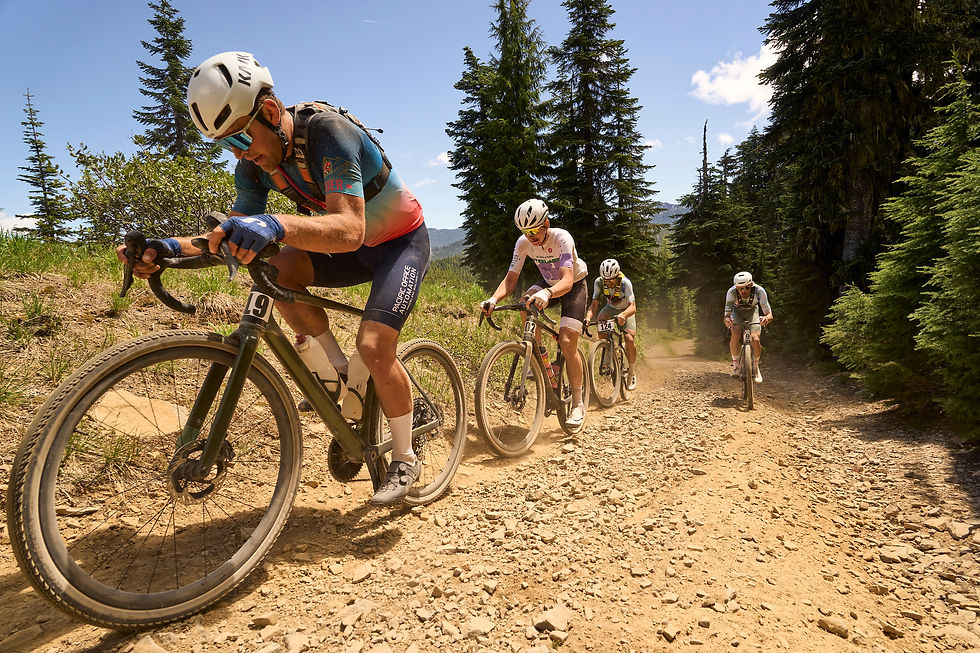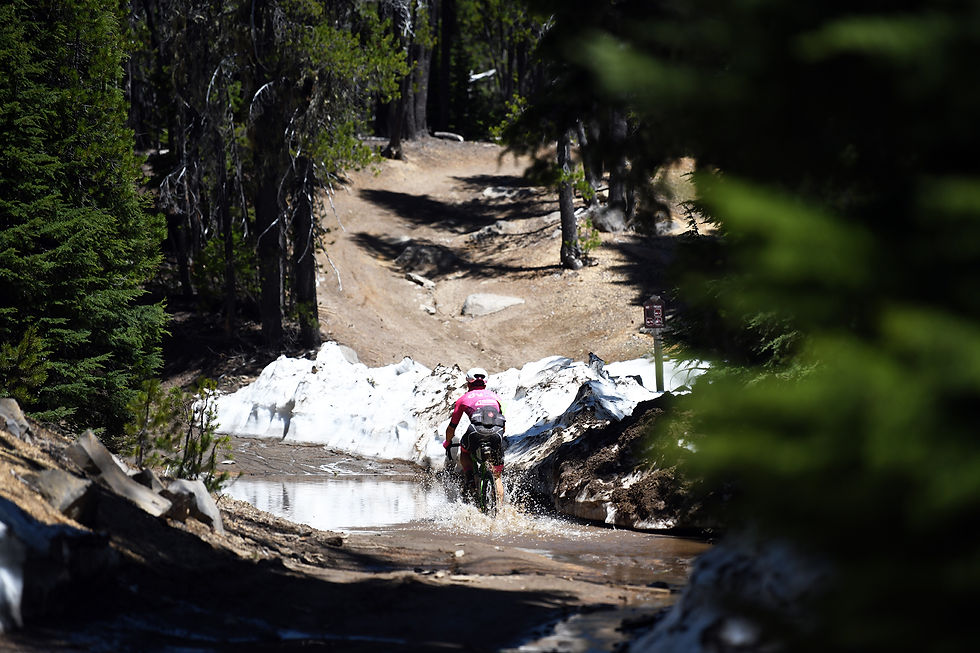Oregon Trail Gravel - The Magic of Gravel Summer Camp
- Chris Mehlman

- Jun 23
- 5 min read
Updated: Jul 3
Words Chris Mehlmann - Photography provided by Oregon Trail Gravel

Oregon Trail Gravel is a unicorn in the best way possible. It sits in the middle ground somewhere between a race and a summer camp for adults. Very few other gravel events in the US are able to provide the same level of racing experience and create an atmosphere that transports riders back to two American childhood rites of passage: sleepaway camp and the Oregon Trail video game.
It’s an event I've had my eyes on since I started racing gravel in 2022, but it never worked out until 2024. Over the course of the five days of fun last year, I was sold on every part of it: the concept, the racing, the people, the camp life, and the general atmosphere that so many races want to have, but so few races are able to create.

On paper, Oregon Trail is a five-day gravel stage race starting and ending in Bend, Oregon. Most stages are point-to-point, with one stage in the middle being a lollipop TT, and crucially, all of the logistics of luggage transport, tent setup, catering, shower facilities, entertainment, aid stations, and just about everything else you could ever want in a race are handled by race organizer Chad Sperry and his crew at Breakaway Promotions.
Since doing the race last year, I’ve been curious about how such a complex logistical operation is possible, and what motivated Sperry to create this type of event. Sperry is no stranger to professional race organizing on the road. He ran the now-defunct Cascade Cycling Classic, helped put on several national championships, assisted in the production of the Tour of Utah, and, as his interest in road dwindled, started a race in Oregon called the Gorge Roubaix. This event was a gravel race before the idea of gravel racing was all the rage, and since then, he has dived into the world of gravel stage racing with Oregon Trail.
Sperry notes that he was inspired by the point-to-point camping format of BC Bike Race along with the early days of the Tour de France, saying that “we're not really inventing something new, we're bringing something back... thinking of those black and white images of the Tour guys riding over those epic mountain passes and through the valleys on gravel roads.” I can see why this image comes to mind. The roads raced upon feel as they they are yours. I can count on one hand the number of cars I saw on the course outside of the neutral start from Bend on stage 1. The views, even in dark moments of physical pain mid-race, are jaw-dropping. Where the race diverges from this hard-man history is in its support. Aid stations dot the course, safety plans are top notch, and there’s always a shower and excellent meal waiting at the end of each stage.

It was striking that what I said was the most lasting impact of the race in my conversation with Sperry, the community aspect and friendships that are made, is exactly what the race director wants every rider to get out of the race. When Sperry insists that “everybody is welcome, from the best pro to that guy that is truly the weekend warrior,” he is not kidding. This year, the Gravel Earth Series race will feature riders such as Sofia Gomez Villafane, Cécile Lejeune, Unbound 200 winner Cam Jones, and Payson McElveen, but frankly, they are no more the stars of the show than any other rider. Normally, there’s an unspoken divide between professional and amateur riders. Pros fulfill their duties as sponsored athletes and then retreat to the safety and peace of their lodging to recover and focus on racing. At Oregon Trail, Cam Jones will be sleeping in the same type of tent as an amateur rider with half the watts as him, but no less energy and passion. The race literally creates a level playing field. It brings pros down to earth and raises amateurs up by inspiring and motivating them through what is a tough week. As someone who works in marketing outside of racing, I strongly believe that this is what racing is about, and this is what pros should be doing at every race, but the increasing intensity and stakes of elite gravel racing have swapped grassroots fun for marginal gains and money in many of the larger events. There is nothing better than finishing a stage in Oregon and lounging in an ice-cold river with every type of gravel rider. Evening drinks, for those interested, conversations, cornhole, music, and delicious food are reminders of why we do gravel.

While it’s hard to pinpoint why Oregon Trail has been able to curate this welcoming experience so well when others have fallen short or lost their way as they’ve grown, the format of the race, the emphasis on camp life over racing only, and the experience of the race crew certainly have a lot to do with it. People often say that the best way to tell how good a place is to live or work is to see how long residents or employees have stuck around. In a field like race promotion, which Sperry describes as “taking years off [his] life,” it’s rare that those doing the grunt work in the wee hours of dawn and deep into the night stay. The fact that many of his staff have been with him from the early days of Breakaway when it was running road events says a lot, and I think Sperry’s skill at creating a positive working environment has dovetailed nicely into his ability to establish and, more importantly, maintain, a race environment that is truly for every rider.

The idea of a point-to-point race like this itself isn’t revolutionary, but putting on an event like this in the US is a different level of complexity compared to most other races. Planning to make this experience possible starts a year in advance, and with the Oregonian weather making access to most of the routes impossible until late May or early June, getting ahead with planning is the name of the game for the race crew so courses are in prime condition by the race. Sperry said that in one recent course work day, he and his crew endured a 9-hour round-trip drive to the location they were working on. After a 5 AM start, they didn’t get home until 2 AM the next morning. Spin Catering, which provides delicious meals, has to work in remote areas without established kitchens or refrigeration. Permits have to be secured along hundreds of miles of course in US Forest Service Land, a process filled with red tape and constant setbacks due to logging and the ever-deteriorating nature of the dirt roads in this mountainous region. I left last year, quite honestly, blown away by the organization of the race. No detail was missed, and for the price of the event, it blows away much of the corporate race competition.
In reflecting on the complexities of running Oregon Trail and the next five years, Sperry hinted that the race is closer to its final edition than its first. In the meantime, his goal remains the same. He measures success not by how many racers sign up, but by the experience each and every individual race has. For this reason, he’ll continue to cap registration at 300-400, continue to search out gravel tracks largely untouched by motorized vehicles, and maintain the closest experience to adult summer camp you can get.
Whether it’s for the racing, the views, the camp life, the food, the camaraderie, or the whole package, Oregon Trail is well worth adding to your list in 2026. It won’t be here forever, and you don’t want to miss it.

Find out more at the Oregon Trail Gravel homepage: https://www.oregontrailgravelgrinder.com/
And on Instagram: https://www.instagram.com/oregontrail_gravelgrinder/#




Comments